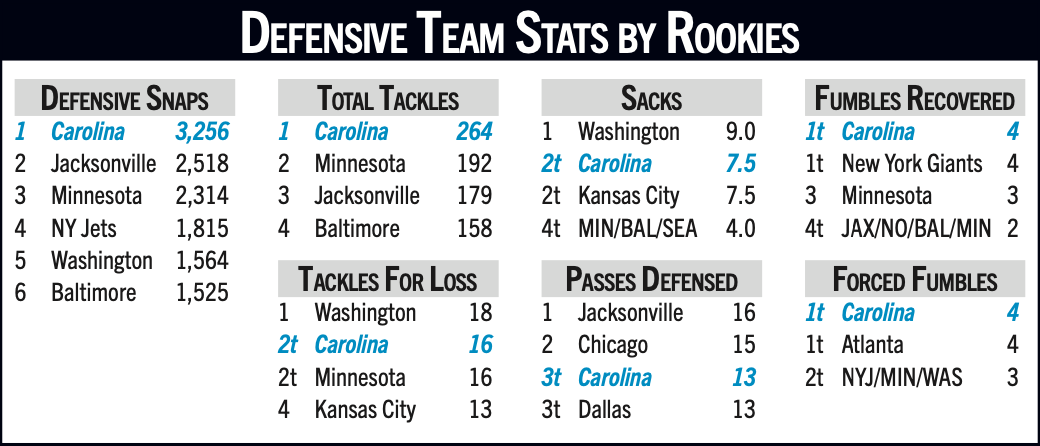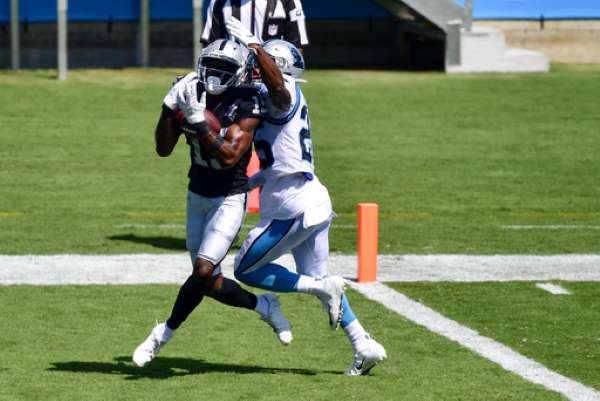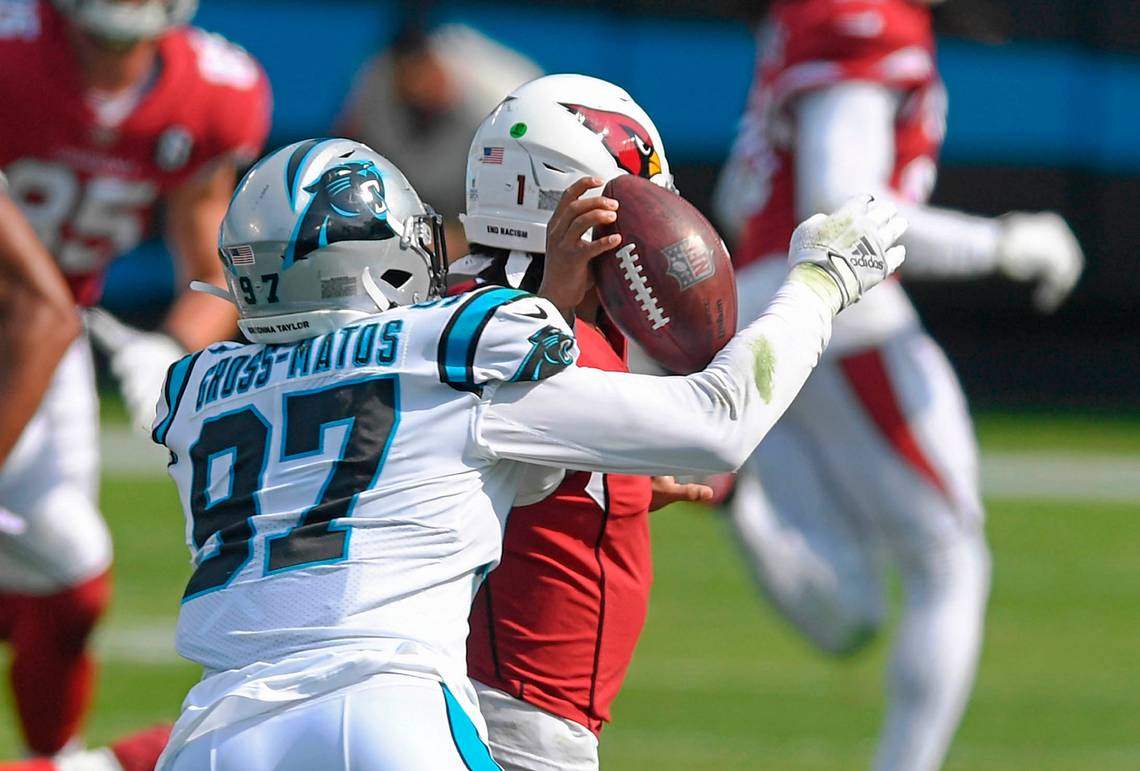With just one game remaining in the Panthers’ 2020 season and with eyes around the Carolinas starting to move towards the draft and the offseason (even if the coaching staff aren’t there yet), much has already been made about the Panthers’ potential draft position and the implications this might have for how the Panthers approach the offseason. However, while the Panthers will undoubtedly add a number of new faces over the coming months, it is worth looking at how the pieces they added last season are starting to come together.
The Panthers lead the league with 264 tackles on defense by rookies, and 3,256 total defensive snaps by players in their first year – all seven of their defensive draft picks have played and six rookies have started at least one game, so there’s at least a bit of a sample size to look at from their rookie class.

Table Via Panthers
With this in mind, how have the Panthers’ 2020 draft (and UDFA) class looked through their first 15 games and how might they fit into what they are building going forwards?
Derrick Brown
Derrick Brown has been pretty good as a rookie – while his statistical output isn’t going to get him in the DROY conversation, with 15 QB pressures (second-most among rookies) eight TFLs and two sacks, he has been reasonably productive in terms of generating negative plays. While those two sacks are going to need to be built upon if he is going to justify being a top-10 selection, his pressures are an indication that his pass rush is more than just his sack production, and his games against Denver and Green Bay late in the season have flashed some really nice things against the pass.
Overall, Brown has been a player capable of the spectacular and has at times looked like the feature piece of the Panthers’ defense that he was drafted to be – but he will need to work on the fundamentals of the game over the course of the offseason in order to make the most of his talent. His pad level needs to be more consistent against both the run and pass and this, in turn, should help his arm extension which should help him to stay active in plays longer.
Grade: B-
Yetur Gross-Matos
YGM has been somewhat limited by injuries as a rookie, playing less than 350 snaps so far this season (Brown has played over 650 and Chinn has played over 900) – Matt Rhule indicated after the game this past week that he is still battling through a nagging injury at the moment.
However, despite playing a limited number of snaps, he has still managed to generate 11 pressures and 2.5 sacks to go with two TFLs. Given that he entered the NFL as something of a developmental piece, and given that he didn’t get an offseason and has missed time with injury, he has been remarkably effective thus far – with another offseason to continue to develop and some more time in an NFL weight room, he has a really bright future.
Encouragingly, having struggled against the run early in the season as he did at times in college, he has made a real effort to improve his pad level and while there are still some things he needs to continue to work on in terms of his run defense, the fact that he has made this much of an improvement over the course of the season bodes well for his future growth.
Grade: C+
Jeremy Chinn
Jeremy Chinn is really, really good.
He has managed to not only make the transition from small-school FCS football to the NFL, but do it while learning multiple positions in an NFL defense and still been able to play at a remarkably high level. He is an excellent tackler is space, covers ground at a rate of knots, has the movement skills to match up with tight ends and running backs in man coverage and the ball skills to make plays on the back end. In terms of how good he can be, there is really very little ceiling to his game.
There are areas he can improve, and a lot of that will just come with time to get used to what he is being asked to do in the defense and the NFL game in general. In man coverage, he should continue to work on his footwork at the head of routes, as he does sometimes allow receivers to create momentary separation as he stops his feet. In zone, he should improve as he gets more used to the defense and doesn’t need to focus quite so much on where he needs to be and can work more on reading the routes and they develop in front of him.
Grade: A-
Troy Pride, Jr.

Photo Credit: Mike McCann/Associated Press
Pride has played roughly half the defensive snaps so far this season, having been a little down the depth chart early in the season and having missed some time with injury over the final few weeks. While he was always something of a developmental pick and was not going to be expected to step into a starting role straight away, it is hard to say that his play has really stood out thus far as he was forced onto the field earlier than the coaching staff wanted or expected.
On 40 targets, he has recorded just two pass deflections with no interceptions, and has allowed a completion percentage of 70% to go with over 14 yards-per-completion. These numbers aren’t good, but they are roughly in line with what you’d expect if you took a random fourth-round corner and threw them out there for over 500 snaps.
Like all the rookies, Pride will benefit from time to adjust to the defense, what he’s being asked to do and the speed of the NFL game.
While I don’t think he has shown enough for the Panthers to go into next season expecting him to nail down a starting role, he has not looked completely lost either. The Panthers would probably have hoped he would have had a gentler transition into playing time, and would probably have liked for him to have shown a little more when he has played, but he certainly has plenty of time to get back on track and should be able to compete for playing time as either the #3 or #4 corner next year.
Grade: C-
Kenny Robinson
Kenny Robinson has played exactly 3 defensive snaps so far this season, and so judging how he is shaping up as a safety is almost impossible. However, it is worth bearing in mind that Robinson was always going to be something of a developmental option entering the NFL – he is the youngest player on the roster (he will not turn 22 until the week after the season) and has come from a year of playing in the XFL. Encouragingly, he has been a fairly regular special teams contributor over the back half of the season, playing in eight of the last nine games and featuring in around 60% of the snaps over that period.
He obviously didn’t get off to the best start in Carolina, and given how raw he was coming out of college, it was certainly disappointing to see the Panthers draft him in the fifth only to release him during final cutdowns. But having brought him back after some time on the practice squad, he now looks to have impressed them enough to be in the conversation with a number of other young DBs to compete for the backup roles behind Chinn, Burris and Boston and potentially play himself into some game-time in 2021 and beyond.
Grade: D
Bravvion Roy
When your sixth-round pick plays over 350 defensive snaps, something has either gone very wrong or you are in a good position in terms of your day three draft class. For the Panthers, it has been a bit of both as while a fair amount of Roy’s play time has been due to injuries at defensive tackle, he has also shown some nice traits up front.
He shows excellent quickness for his size and his potential as a penetrating disruptor against the run was especially evident early against the Packers – while he is unlikely to ever excel as a pass rusher, he has managed to generate seven pressures, five QB hits and a sack, to go along with two TFLs.
He does, however, also have some real room to grow. His pad level need to improve significantly, and he is still too easy to move in the run game a lot of the time this should in turn make things easier for him in terms of both hand placement and arm extension, but if he can work on these areas, he has a chance to continue to be a significant rotation piece going forward when the Panthers hopefully have a more complete range of defensive line options.
Grade: B
Stan Thomas-Oliver
STO is another player who it is hard to judge based on 2020 – having played only two seasons at corner in college after converting from receiver, he was drafted very much as a developmental option to sit for a year and learn before competing more seriously for playing time in 2021. The fact that he has played 60 defensive snaps is more a reflection of how short of bodies the Panthers have been at times on defense rather than a reflection of what the expectations for him should be.
Yes, he has allowed a perfect passer rating on seven targets, allowing seven receptions for 97 yards and a touchdown, but judging a seventh-round corner who was playing receiver as recently as the 2017 season on the basis of seven targets as a rookie seems a little foolish. Like with Pride, he has broadly performed how you would expect somebody drafted where he was drafted to play if thrown to the wolves early.
He needs to continue to work on his game over the offseason and will very much be on the edge of the roster entering training camp in all likelihood, but that’s about what you’d expect from the 221st pick in the draft.
Grade: C-
Rodney Smith
The Panthers are pretty loaded at running back, and while Trenton Cannon is essentially a special teams player, the fact that the Panthers #4 RB who got cut early in camp is as good as Smith is remarkable. While he has played just 94 offensive snaps this year, he has 37 carries at 3.7 ypc (Mike Davis is averaging 3.9 behind what has become an increasingly injured offensive line) and has caught eight of 10 targets for 55 yards. While neither of these are exceptional, they are legitimate NFL running back numbers and regardless of whether the Panthers bring Davis back or not in free agency, Smith should enter training camp next year with an outside shot to make the roster – he has certainly done enough to catch some eyes around the NFL.
Grade: C+
Sam Franklin
Franklin is another player who has played a lot of snaps in part due to impressing in camp and in part due to the injuries that have occurred higher up the depth chart.
While he hasn’t played any defensive snaps since the Panthers’ loss to the Bucs, he has established himself as a useful piece on special teams and has shown enough to be in a position to compete for a roster spot again next year. He did have some nice flashes against the Chiefs and has managed a sack, a TFL and a pass deflection this season – but he did at times look pushed to his athletic limits in coverage and is probably better suited to playing as the backup to Jeremy Chinn than competing for a starting role alongside him. Not likely to be a key piece of the Panthers’ defensive moving forward, but a useful player to have and excellent value as a UDFA.
Grade: B-
Myles Hartsfield
When you are playing both running back and defensive back in camp, you are always going to be at a disadvantage when it comes to mastering one position. While Hartsfield’s versatility likely helped him make the 53, the fact that he seems to have supplanted Corn Elder as the primary nickel corner over the past three games is a good indication of how he has been able to develop with the time to focus on playing defense. Matt Rhule spoke after the game against Washington about how he has been able to grow in terms of role over the season:
“He’s really emerged as kind of the nickel for us, he’s played well – really well – the last couple of weeks,” said Rhule. “He’s developed on special teams and then grown as a player through the course of the year and now’s getting some big-time opportunities and making the most of them”
Like with STO, he has played so few snaps that it’s hard to make a firm judgement, but having been targeted five times, he has done well to give up just 40 yards on three completions to go with a pass deflection. If the Panthers’ don’t resign Elder, it looks like Hartsfield will have a chance to win the starting nickel role – even if he hasn’t really played enough to make a stronger statement than that.
Grade: B
Joseph Charlton
When Charlton shanked a couple of punts in camp, people started to edge close to the panic button – while he hasn’t been perfect, he has been genuinely good as a rookie and should give the Panthers a legitimate punting competition in camp next year.
He ranks 15th in the NFL in average punting yardage at 46.3 but what is even more impressive that he has had an astonishing 50% of his punts downed inside the 20, including ALL FIVE last week against Washington that earned him an NFC Special Teams Player of the Week nod. That is a mark that is way ahead of where Palardy was a season ago and is in the same kind of ballpark as prime Johnny Hekker and Dustin Colquitt.
While it’s unlikely the Panthers are able to flip a spare punter for major draft capital next August, having a top tier young punter in competition with your other legitimately very good punter is a good position to be in. Oh, and he is 1-1 for 28 yards when throwing the ball as well.
Grade: A+
(Top Photo Via David T. Foster III/Charlotte Observer)



